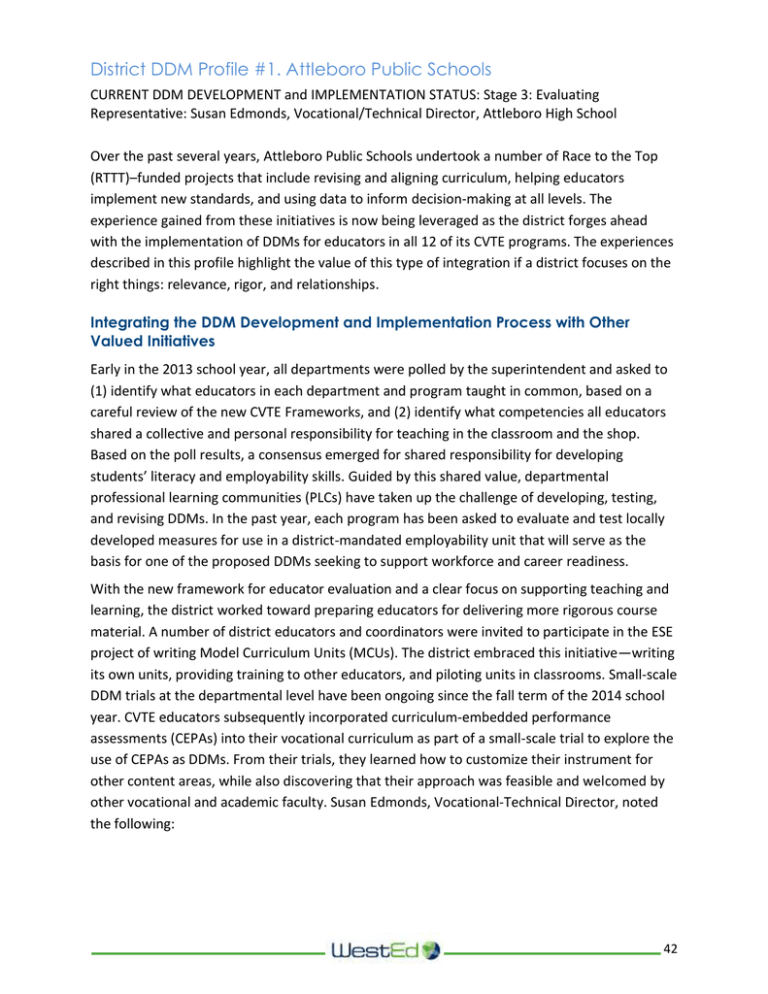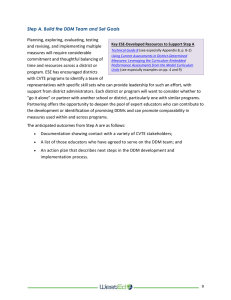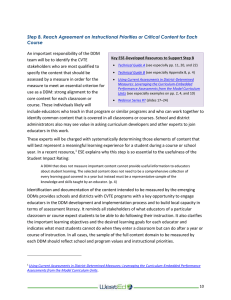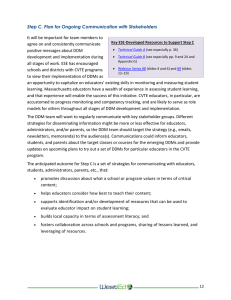profile1
advertisement

District DDM Profile #1. Attleboro Public Schools CURRENT DDM DEVELOPMENT and IMPLEMENTATION STATUS: Stage 3: Evaluating Representative: Susan Edmonds, Vocational/Technical Director, Attleboro High School Over the past several years, Attleboro Public Schools undertook a number of Race to the Top (RTTT)–funded projects that include revising and aligning curriculum, helping educators implement new standards, and using data to inform decision-making at all levels. The experience gained from these initiatives is now being leveraged as the district forges ahead with the implementation of DDMs for educators in all 12 of its CVTE programs. The experiences described in this profile highlight the value of this type of integration if a district focuses on the right things: relevance, rigor, and relationships. Integrating the DDM Development and Implementation Process with Other Valued Initiatives Early in the 2013 school year, all departments were polled by the superintendent and asked to (1) identify what educators in each department and program taught in common, based on a careful review of the new CVTE Frameworks, and (2) identify what competencies all educators shared a collective and personal responsibility for teaching in the classroom and the shop. Based on the poll results, a consensus emerged for shared responsibility for developing students’ literacy and employability skills. Guided by this shared value, departmental professional learning communities (PLCs) have taken up the challenge of developing, testing, and revising DDMs. In the past year, each program has been asked to evaluate and test locally developed measures for use in a district-mandated employability unit that will serve as the basis for one of the proposed DDMs seeking to support workforce and career readiness. With the new framework for educator evaluation and a clear focus on supporting teaching and learning, the district worked toward preparing educators for delivering more rigorous course material. A number of district educators and coordinators were invited to participate in the ESE project of writing Model Curriculum Units (MCUs). The district embraced this initiative—writing its own units, providing training to other educators, and piloting units in classrooms. Small-scale DDM trials at the departmental level have been ongoing since the fall term of the 2014 school year. CVTE educators subsequently incorporated curriculum-embedded performance assessments (CEPAs) into their vocational curriculum as part of a small-scale trial to explore the use of CEPAs as DDMs. From their trials, they learned how to customize their instrument for other content areas, while also discovering that their approach was feasible and welcomed by other vocational and academic faculty. Susan Edmonds, Vocational-Technical Director, noted the following: 42 This integration of content from several disciplines and the increased engagement that educators experienced while developing the CEPAs have been transformative for students and educators alike. Students can now demonstrate what they know and can do, while educators can more readily and comprehensively sample and measure the standards and skills students have attained or are in the process of developing more fully. Ms. Edmonds’s CVTE colleagues also designed a CEPA focused on measuring employability skills (see the Attleboro employability unit in Appendix A). CEPAs’ performance-based approach to assessment makes them familiar and appealing repeated measures that academic and CVTE educators can readily use to improve literacy. Ms. Edmonds has found that these locally developed CEPAs can be powerful tools that help educators better integrate reading and writing into assignments and assessments in all subject areas. Across the district, professional development focused on ESE’s MCUs and the development of CEPAs has fueled much interest and joint effort by faculty who are eager to apply what they have learned through the DDM development effort. Evaluating Currently Used Assessments across Academic and CVTE Programs Toward the end of the 2013 school year, the district superintendent charged the district data coordinator with visiting each teaching department, whether academic or CVTE, to begin polling educators about their current inventory of assessments and tests, with the goal of identifying a few growth measures that could be used as DDMs. Each department was charged with identifying and recommending two measures to the superintendent. Table 9. Measures Currently Used at Attleboro High School Employability and Career Readiness SkillsUSA Technical Skills Attainment Industry certification (e.g., ServSafe©) SkillsUSA Competency tracking system Local measures based on skills-based competency tracking In response to the superintendent’s call to action, Ms. Edmonds mobilized a group of volunteers to form a task force that could help her department design and test measures for use as DDMs. Ms. Edmonds and the task force: 1) designed an instructional unit on employability and career readiness, and 2) created a curriculum, assignment prompts, and related instructional support materials (e.g., assessments, handouts, and worksheets). The task force decided to implement its DDM trials around this newly developed two-week employability and career readiness unit, with the objective of fine-tuning accompanying formative and summative assessment tools during the fall. 43 The district’s small-scale tryout plans called for all 12 CVTE educators to deliver the same unit of instruction to their grade 10 students during the second trimester of the school year. In December 2013, educators in all district CVTE programs delivered the same instruction and administered the task force–developed pilot assessments. Approximately 150 grade 10 students in 12 CVTE courses received instruction in the new employability unit and subsequently took the assessment created to accompany the unit. CVTE educators convened a data review meeting for their December PD, during which they increased their capacity to analyze and use assessment data by examining item p-values, point-biserials, and frequency distributions. A sample of that employability unit, Communicating within the Career and Technical Field, is shown in Figure 3. The unit includes a list of the standards and key competencies intended to be measured, an instructional materials checklist, lesson plans, and pre-tests/post-tests. 44 Figure 3. Sample of Employability Unit and Assessment Strand 4 Unit Objective Students will be able to show effective communication skills in the career and technical field using multiple modes of communication. Employability Standards Addressed: 4A. Develop employability skills to secure and keep employment in chosen field. 4B. Communicate in multiple modes to address needs within the career and technical field. 4D. Demonstrate positive work behaviors. Key Competencies Reading and Writing Oral Communication Skills Active Listening Skills Data Literacy Workplace Etiquette/Protocol Goal Setting Self-Management Instructional Materials Five-day curriculum (pre-tests/post-tests, handouts, & worksheets) Assignment #1: Mock Interview Performance and Product Rubrics Assignment #2: Draft Resume & Cover Letter completion Assignment #3: Completion of a job application & W-4 / I-9 forms Worksheet completion (“Get Serious about Goal Setting”) Employability Assessment Day One of Employability Unit: Major Activities / Projects / Lessons Effective Workplace Communication, Oral Communication in the Workplace, & Proper Phone Etiquette Activator: Have each student list 3 different types of people that he or she communicates with on a daily/weekly basis. Have students get into pairs to discuss, choose 3 out of the 6 total, and write down how they would address each of those 3 people. Square the groups of two and pass out “Flipping the Switch” worksheet. Give each group one situation to complete/act out/draw, etc. (their choice) for each type of person listed (or for each type of person that they came up with earlier). Upon completion, discuss each situation as a class, and the importance of proper oral communication depending on whom you’re conversing with. Pass out “Business Conversation Etiquette” and “Telephone Etiquette at Work” worksheets to each group of 4. Divide reading into 4 sections. Have each student read one assigned section, highlight important points, and discuss within their group. Then discuss as a class. Explain importance of proper oral communication in the workplace and various situations, including diversity in the workplace (e.g.: phone calls, formal meetings, informal meetings). Consolidating Activity: On an index card (or scrap paper), in complete sentences, have the students write down 3 new etiquette rules they learned/went over today in class. Capitalizing on the Opportunity to Promote Effective Teaching Practices According to Ms. Edmonds, the district sees educator evaluation as an opportunity to be forward-thinking and has used the DDM initiative to ensure that all other district efforts are focused on teaching and learning. “We didn’t want the DDM initiative to be an island,” she says. Administrators also knew they could not do this sensitive work alone. From the outset, 45 educators were seen as active partners. The district also embraced the local teachers association as a full partner and collaborated closely with them along the way to ensure that all educators were well informed and involved, using open dialogue and frequent communication—making it clear that the central purpose of the DDM initiative is to give educators constructive feedback to help them grow as professionals. Simultaneously, with a clear focus on supporting teaching and learning, the district worked toward preparing educators for delivery of rigorous course content. Applying Lessons Learned from Administering a Common Assessment The Attleboro DDM task force has learned a great deal about designing and developing formative and summative assessments as they worked to implement the new employability instructional unit and assessment. After their trial this winter, CVTE educators have been working to revise the unit and assessment to better accommodate lessons learned, as well as to further customize unit curriculum for each particular CVTE program. They have compiled a list of lessons learned that they hope will support development of a DDM for applied literacy and communications. Valuable lessons learned include the following: Task force members saw real value in measuring both knowledge (academic content) and technical skills (performance), but acknowledged that it is challenging to find the right balance between the two. For assessing academic content, multiple-choice and open-response items can be effective when used judiciously and strategically. Open-response items are best used to measure critical thinking and problem solving. For assessing performance, the task force sought to go beyond a simple checklist, as it does not capture the types of growth data needed for measuring educator impact on student learning. They found that hands-on demonstrations and/or practical problem-solving prompts are most effective (especially if already in use). Effective performance measures require strong rubrics with discrete performance levels described for each growth boundary. Rubric development should be conducted with input from industry advisors. Although it is challenging and time intensive, developing rubrics provides an opportunity for professional learning and promotes communication. 46 Process maps, task lists, competency audits, and portfolio-/project-based evaluation rubrics will be familiar to most educators. It will be important, however, to ensure that the DDM measures growth and not just achievement. Attleboro Public Schools have multiple CVTE programs, and, to promote comparability across programs, the task force thought it was important to set a standard for cognitive demand across all measures used to assess technical skills attainment. If all goes as planned, the task force will propose to the district superintendent that both the employability unit and a competency-based tracking system be adopted for use as the DDMs in all district CVTE programs. 47



